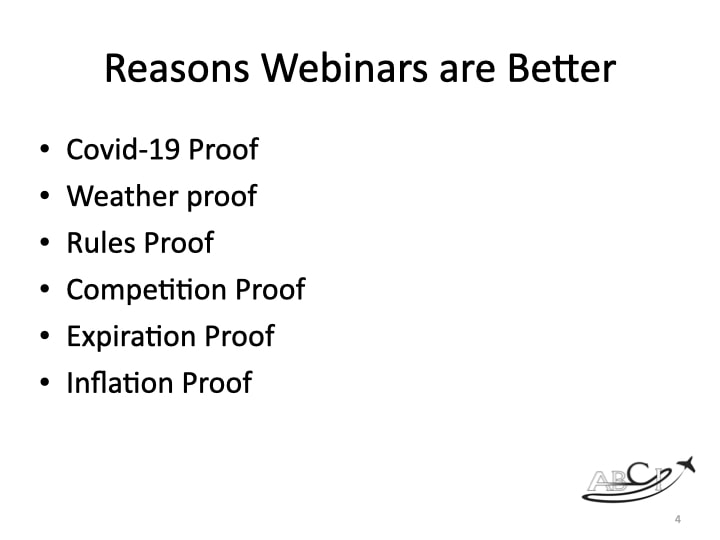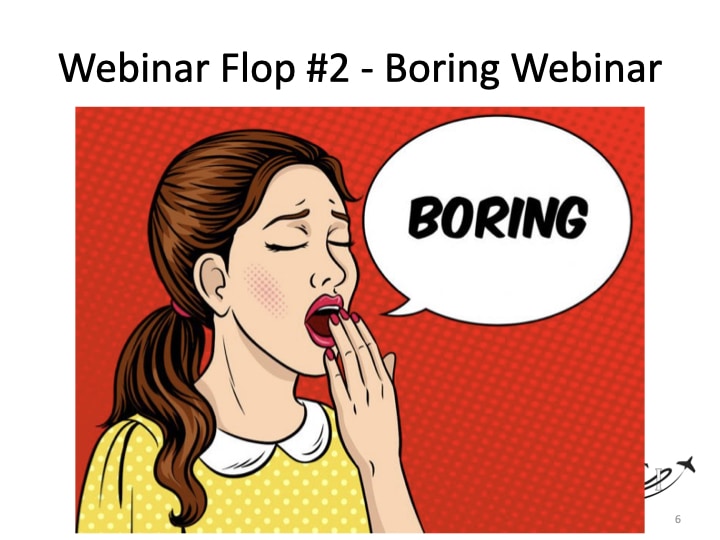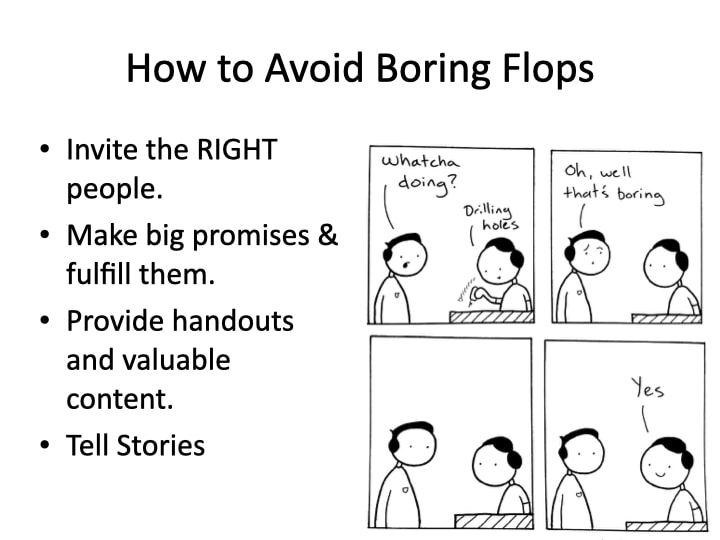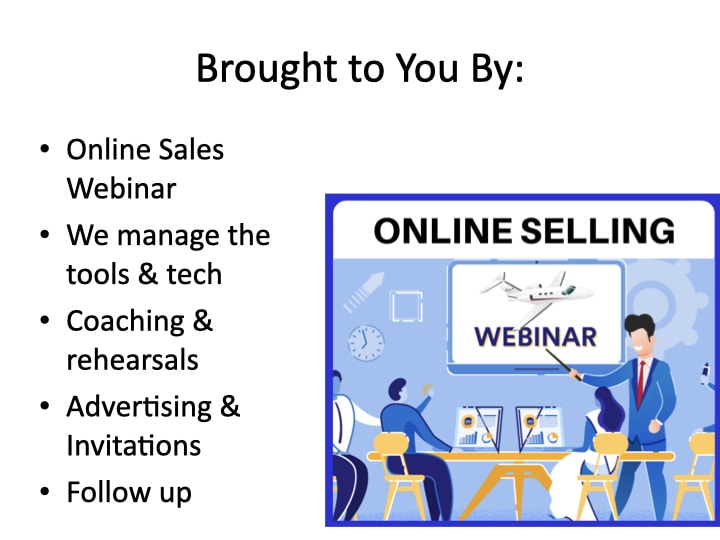Two reasons webinars fail – conquer these, and you can host webinars with confidence!
Many aviation business owners, and sales and marketing execs, would like to host a webinar. Since conferences and events in the spring and summer of 2020 are getting cancelled or postponed, webinars are a fantastic way to reach potential customers.
You can engage in a long-format venue, explain complex products and services, demonstrate products, answer questions, and spend some time building trust and fostering the relationship.
But two things can go very, very wrong.
[fusebox_track_player url=”http://traffic.libsyn.com/aviationmarketing/Webinar_fails.mp3″ background=”default” social_linkedin=”true” ]
How to Avoid Webinar Fails – The Transcript
Paula Williams:
Welcome to this week’s episode. I’m Paula Williams.
John Williams:
John Williams.
Paula Williams:
And we are ABCI, and ABCI’s mission is-
John Williams:
To help all you ladies and gentlemen out there sell more products and services in the aviation world.
Paula Williams:
Absolutely. So last episode we talked about reasons you should do a webinar. Today is the cautionary tale or the reverse of that. Six reasons that bad webinars fail.
John Williams:
Well, if they’re webinars, they’re not bad unless they fail, right?
Paula Williams:
That is true, but there are bad webinars. I’m sure you’ve been to some, right?
John Williams:
Yes, I have.
Paula Williams:
All right. So let’s not do that. Okay.
This Episode is Brought to You By Our Aviation Webinar Service
So this episode is brought to you by our webinar service where we put together, we help you put together in collaboration, a fabulous webinar that is really going to be compelling for your ideal customer and help demonstrate your product or service and explain why you are the best option for them. And it’s really good for long-cycle marketing complex products and services in the aviation industry and really helps move that sales process along.
Paula Williams:
And we do a lot of the technical and weird stuff and help you do what you’re good at, which is demonstrating your product and showing it in the best possible light, right?
John Williams:
Mm-hmm (affirmative).
Paula Williams:
Okay. So last week we talked about webinars versus aviation trade shows and that’s probably the best comparison.
Trade Shows are Fantastic. But They Have Shortcomings
There are two ways, really, to demonstrate a complex product or service. People love to get their hands on things. People love to see things work. And a trade show is probably the very best, and it’s certainly the most traditional way of making that happen.
Paula Williams:
But there are a couple of things that are shortcomings for trade shows, right? Webinars are COVID-19 proof, right?
John Williams:
Can you imagine trying to keep six feet in between you and everybody else out there?
Paula Williams:
Exactly. I can just envision this sea of navy blue suits all six feet apart, and then going out into the parking lot, six feet apart, with dots on the floor so that-
John Williams:
Trying to find a restaurant that’s open.
Paula Williams:
Oh heavens, exactly. Certainly shows this summer are going to be impacted by the COVID-19 situation. So webinars are also weather-proof, right? Like Hurricane Harvey in 2017, which really impacted attendance at the Florida shows. I’m sure there’s been a lot of aviation shows over the years that have been impacted by weather. So that’s not the only one that was disappointing.
John Williams:
Right.
Rules at Trade Shows Make it Harder to Get Attention, Connect & Make Sales
Paula Williams:
They are rules-proof. If you have seen the exhibitor guide from any of these big shows and all of the things that you can and can’t do.
John Williams:
Mostly it’s what you can’t do.
Paula Williams:
Right. You’re paying a lot of money for not being able to do a lot of things, right?
John Williams:
Right.
There is a TON of Competition at Trade Shows
Paula Williams:
Okay. Competition-proof. If you run a webinar, it is your show and you control the agenda and you invite people that you want to come.
John Williams:
Right.
Paula Williams:
You’re not competing with the big kids with the shiny objects that everybody wants to go see. You’re not competing with the marching bands and musicians and cocktail hours that are going on elsewhere in the convention. You get to keep your customers interested and talking about your product or service.
Paula Williams:
They’re expiration-proof. So you do a webinar and you get to keep the recording and you get to continue to use that long after the fact. It’s inflation-proof, meaning costs of trade shows are going up by the year.
John Williams:
Oh, every year they go up.
Paula Williams:
Right. But there are some bad things that can happen with webinars. So those were the good things.Webinars are a great way to make sales, and to revive dead prospects, and give you a reason to communicate with the folks in your pipeline that isn’t just “are you ready to buy yet?” Instead you’re offering them something by inviting them to an educational webinar.
The differences between a trade show and a webinar.
Paula Williams:
Some of the bad things are you are the only one who is responsible for inviting people to this webinar and making sure that you fill the room. When you go to a trade show, you’re sharing that responsibility with everyone else, right?
John Williams:
Mm-hmm (affirmative).
Paula Williams:
Okay. So we have to do a good enough job of marketing to get the butts in the seats, right?
John Williams:
So to speak.
Paula Williams:
Right. So we need to have the people invited to the webinar, they have to know about it, they have to understand why it will benefit them to spend the time to come to this webinar. We have to offer something that is of value in order to make that not be a flop, right?
John Williams:
Yes.
We All Dread the Boring Webinar!
Paula Williams:
Okay. Flop number two is that your webinar could be really boring, right?
John Williams:
Mm-hmm (affirmative).
Paula Williams:
Okay. So we’re going to talk about how to avoid these two kinds of flops. Either not having anyone show up or having it be terribly boring. Okay. So how to avoid attendance flops. Your webinar has to sound like more fun than the Donner Party. Right?
Paula Williams:
And there’s a cartoon on the screen for those of you who are listening, you’re invited to the Donner Party. It’ll be a cool time. All you can eat until all the guests are gone. So it’s a possibly a inside Mormon joke. I don’t know if that’s … other people know about the Donner Party, do they?
John Williams:
Oh, I’m sure they do. That was …
Paula Williams:
All right. It was a news event in the westward expansion of the United States where a group of settlers got stranded and theoretically ate each other, or at least that’s the urban legend. And so yeah, your webinars should not be that dire, okay?
Did You Really Host A Webinar If Nobody Shows Up?
Paula Williams:
So, ways to avoid attendance flops. You want to start planning at least four weeks in advance-
John Williams:
At least.
Paula Williams:
… and start advertising at least four weeks in advance. You want to sell the webinar as diligently as if people were paying to attend. So you want to get your sales guys on the phone inviting people to the webinar, which is actually a much easier call to make than a sales call. “Buy my product” is a harder pitch than, “We’re having a webinar on June 3rd and we’d like you to come.”
Multiple Advertising Media
Paula Williams:
You want to use multiple media to invite people and do you want to invite enough people because only a small percentage is actually going to be available at that day and time and is going to be interested in your particular product or service.
John Williams:
And because you’re going to have to pick a day and time, and all these people may want to be there, but only a portion of them will be able.
Paula Williams:
Right. And there’s a lot of statistics that we can use to help us figure out the right day and time. usually in the middle of the week is better. Usually late morning is better, There’s lots of things that we can can look into in terms of are your ideal customers East coast or West coast?
Paula Williams:
How can we make that the best possible time, but still, it’s not going to be convenient for everybody.
John Williams:
Right.
Paula Williams:
Okay. So how to avoid boring flops. Number one is to invite the right people, because there are some people that will find your topic fascinating no matter how obscure or how detailed or how nerdy you get, there is a group of people that is really interesting in that topic, right?
John Williams:
Yep. And they’re going to say, Are you kidding me? That’s for real?” Regardless of what it is.
Paula Williams:
Right. So you want to make sure that you’re going to invite people who really are your ideal customers and those are people who are really going to be interested in your product.
John Williams:
Exactly.
Paula Williams:
Okay. And we can talk about how to narrow that down. Demographics, psychographics, geography, size of company, position in the company. There’s lots of ways that we can drill down on that and that’s part of the process that we go through.
John Williams:
And that’s part of what we help you with.
Paula Williams:
Exactly. When we’re setting up your webinar.
Make it Useful, Whether People Buy Your Product or Not
Paula Williams:
Second thing is you want to make big promises and fulfill them. So you want to say, “By the time you leave this webinar, you will know X, Y, and Z,” and it has to be useful information whether they become your customer or not.
Paula Williams:
So for example, this podcast, you’re going to know the two biggest ways that webinars can flop and how to avoid it, right? So that’s something that’s useful whether you become an ABCI customer or not.
Paula Williams:
The third thing is you want to provide handouts and valuable content so that they will want to show up and they are going to want to get a checklist or a guideline or something that is useful to them in their job, right?
John Williams:
Yep. You can do some of this with snail mail, you can do some of this with email. You can do some of it online.
Paula Williams:
Exactly.
John Williams:
During the webinar.
Advertise Your Webinar as Avidly As You Advertise Any Other Product
Paula Williams:
Exactly. Right. You can do almost all of it online, but we do recommend postcards in addition to that, because mixed media is more credible and more effective.
Paula Williams:
And then the last one is you want to tell stories rather than providing a bunch of statistics, right?
John Williams:
Mm-hmm (affirmative).
Paula Williams:
And so if you can have a happy customer telling their story, “This is how we use this product and these are the results that we got.” Or you want to go through some of our old podcasts about how to tell a story and relate that in a way that has a beginning, a middle and an end, so that it makes sense and so that it is a narrative that people really get sucked into and need to find out how it ends. Right?
John Williams:
Yep.
Technical Difficulties -Please Stand By . . .
Paula Williams:
Okay. Something wrong?
John Williams:
Nope. I thought I had some things wired wrong.
Paula Williams:
Uh-oh.
John Williams:
We have to do this all over again.
Paula Williams:
Oh heavens. That will not happen during your webinar. Actually we do a lot of double-checking for podcasts and for other things just to make sure that we don’t have technical problems right?
John Williams:
Yep.
Paula Williams:
Okay. Or if we do, then the best thing to do is keep a good sense of humor about it and carry on, and we will find a way to work through it and get around it. So the show must go on, right?
John Williams:
Yeah, absolutely.
Stories Over Statistics
Paula Williams:
Okay. So that being said, tell stories rather than give boring statistics. Here are some statistics. Okay.
John Williams:
Hopefully they are boring.
Paula Williams:
Right, exactly. And we shared these last week as well. 73% of B2B marketers say that webinars are the best way to generate high quality leads. 61% of B2B marketers rate webinars as the most effective content marketing strategy and use them for lead generation, thought leadership training, internal communications, and more. And 28% of registrations occur after the webinar is over.
Paula Williams:
So those have a lasting value. Even after the date of your webinar, you still have that recorded webinar on your website or that people can still get access to.
John Williams:
Right.
Paula Williams:
So we’ll talk through all of the whys and wherefores and hows and how-tos and everything else in an upcoming webinar.
Paula Williams:
Right. And so the date and time is TBD, but we’ve given a lot of webinars in the past and they’ve always been a really good opportunity for us to connect with people and to help people understand a particular concept or situation. Right?
John Williams:
Mm-hmm (affirmative).
Paula Williams:
Okay. So once again, this episode has been brought to you by our Aviation Webinar Service. It’s specifically designed to help you sell a product or service in the aviation industry. So this is not for technology, this is not for software, this is not for any of those things unless it is in the aviation industry and for aviation people, all right?
John Williams:
Right. We’re aviation-specific in everything we do.
We Manage the Tools & Tech. You Focus on Explaining Your Product & Communicating with Your Customers.
Paula Williams:
Absolutely. So we manage the tools and tech for you. You don’t have to no. All that stuff. You don’t have to buy all of the tools and everything else. We’ll walk you through how to set up your equipment, usually using things that you already have or things that are a reasonably cost … or have a reasonable cost for your situation and so on.
Paula Williams:
John’s really good at doing the the hardware consultation end of this sort of thing. So-
John Williams:
I am. I mean, I am.
Paula Williams:
Of course you are, setting up your lighting and your sound and everything else to make sure that it’s going to be the quality that you want.
John Williams:
Well, I haven’t made all the mistakes, that I made a lot of them.
Coaching and Rehearsals Make All the Difference!
Paula Williams:
Exactly. We do coaching and rehearsals to help you become more comfortable doing the webinar and using the tools, which you won’t really have to do. We manage a lot of the chat rooms and other kinds of things that are going on while your webinar is happening. So all you have to focus on is talking to your customers and demonstrating your product, which is what you do anyway, right?
John Williams:
Right.
Paula Williams:
Okay. We do all the advertising and invitations and everything else and we do all of the follow up. So thank you for joining us and we will see you next time.
John Williams:
Stay wealthy. Talk to you later. Talk to you.
Paula Williams:
Stay wealthy?
John Williams:
Healthy, wealthy and wise.
Paula Williams:
Absolutely. See you next time.
No Fields Found.
Podcast: Play in new window | Download
Subscribe: Google Podcasts | Spotify | Amazon Music | RSS














Leave A Comment